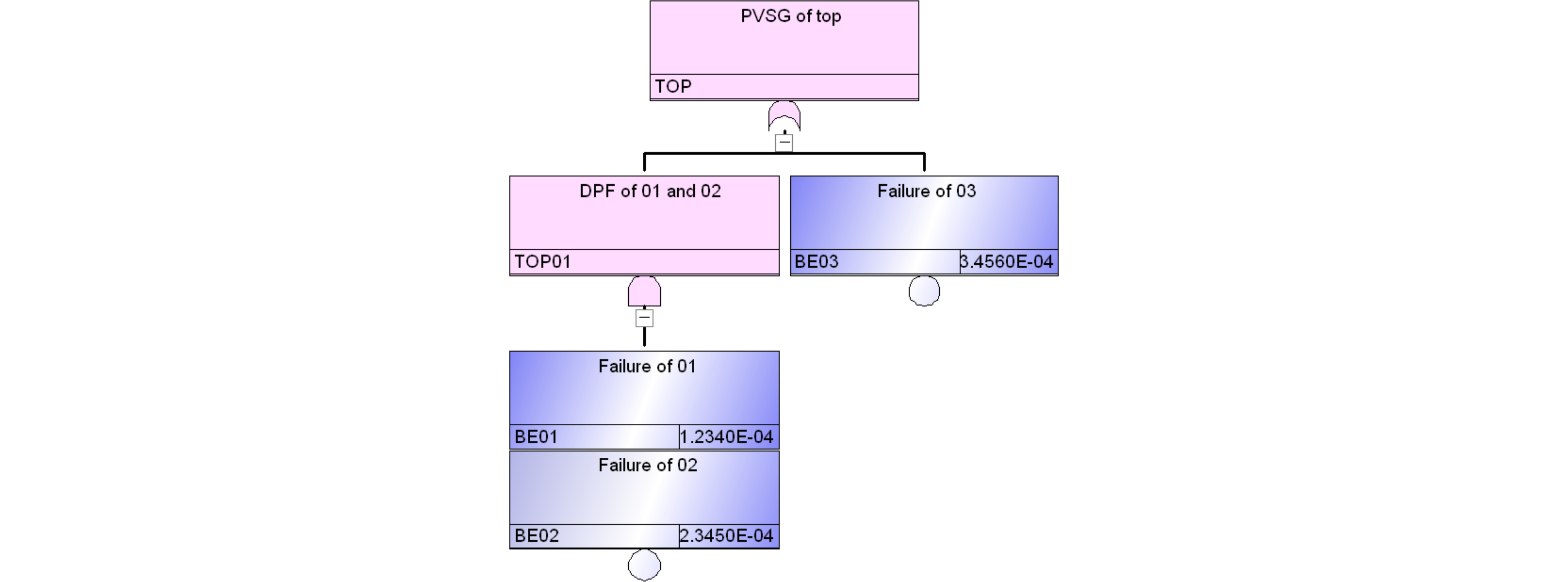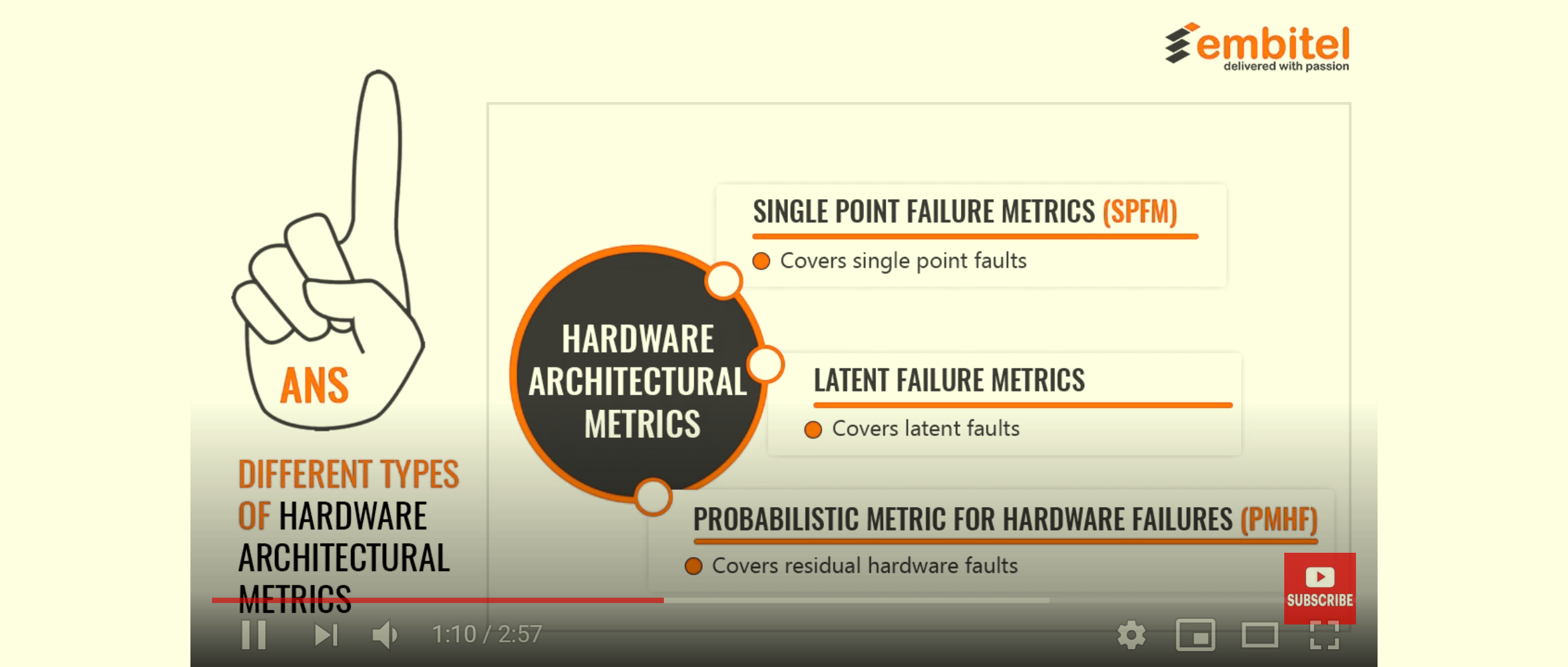 |
20 |
Fault treeの自動生成 (2) |
 |
それでは現実の回路でのトライアルを行います。まず受動部品から成るエレメントELEM1を取り上げます。 受動部品には以下のように抵抗とキャパシタが含まれます。
| 部品番号 | 部品種類 | 故障率[FIT] |
|---|---|---|
| C1000 | Capacitor | 0.065 |
| C1001 | Capacitor | 0.065 |
| R1000 | Registor | 0.011 |
| R1001 | Registor | 0.011 |
| R1002 | Registor | 0.011 |
| R1003 | Registor | 0.011 |
| C1010 | Capacitor | 0.065 |
| C1011 | Capacitor | 0.065 |
| R1010 | Registor | 0.011 |
| R1011 | Registor | 0.011 |
| R1012 | Registor | 0.011 |
| R1013 | Registor | 0.011 |
原始シート準備
エクセルシートを新規に開き、部品情報をSheet1のA1からB12まで並べます。並べるとSheet1は以下の図のようになります。

BED
準備としてSheet2に基本事象の部分を作成します。A1セルに
=IF(Sheet1!A1<>"",CONCATENATE(Sheet1!A1,", ",Sheet1!A1," ",Sheet1!B1,", TEST"),"")
この式を入れ行コピーを必要分行います。するとSheet2は以下の図のようになります。

Sheet2をコピーし、以下のようにBEDファイルの* Name ...のコメント行以下にペーストします。
*Saphire 8.2.9
TEST =
* Name , Descriptions , Project
C1000, C1000 Capacitor, TEST
C1001, C1001 Capacitor, TEST
R1000, R1000 Resistor, TEST
R1001, R1001 Resistor, TEST
R1002, R1002 Resistor, TEST
R1003, R1003 Resistor, TEST
C1010, C1010 Capacitor, TEST
C1011, C1011 Capacitor, TEST
R1010, R1010 Resistor, TEST
R1011, R1011 Resistor, TEST
R1012, R1012 Resistor, TEST
R1013, R1013 Resistor, TEST
BEI
準備としてSheet3に基本事象情報の部分を作成します。A1セルに
=IF(Sheet1!A1<>"",CONCATENATE(Sheet1!A1, ", 3, , , 0.000E+000, 0.000E+000, ",Sheet1!C1,"E-9",", 0.000E+000, 1.000E+005, , , 0.000E+000, 1.500E-003, ,RANDOM, CD, TEST"),"")
この式を入れ行コピーを必要分行います。するとSheet3は以下の図のようになります。

Sheet3をコピーし、以下のようにBEIファイルの* Name ...のコメント行以下にペーストします。
*Saphire 8.2.9
TEST =
* Name ,FdT,UdC ,UdT, UdValue, Prob, Lambda, Tau, Mission, Init,PF, UdValue2, Calc. Prob, Freq, Analysis Type , Phase Type , Project
C1000, 3, , , 0.000E+000, 0.000E+000, 0.065E-9, 0.000E+000, 1.000E+005, , , 0.000E+000, 1.500E-003, ,RANDOM, CD, TEST
C1001, 3, , , 0.000E+000, 0.000E+000, 0.065E-9, 0.000E+000, 1.000E+005, , , 0.000E+000, 1.500E-003, ,RANDOM, CD, TEST
R1000, 3, , , 0.000E+000, 0.000E+000, 0.011E-9, 0.000E+000, 1.000E+005, , , 0.000E+000, 1.500E-003, ,RANDOM, CD, TEST
R1001, 3, , , 0.000E+000, 0.000E+000, 0.011E-9, 0.000E+000, 1.000E+005, , , 0.000E+000, 1.500E-003, ,RANDOM, CD, TEST
R1002, 3, , , 0.000E+000, 0.000E+000, 0.011E-9, 0.000E+000, 1.000E+005, , , 0.000E+000, 1.500E-003, ,RANDOM, CD, TEST
R1003, 3, , , 0.000E+000, 0.000E+000, 0.011E-9, 0.000E+000, 1.000E+005, , , 0.000E+000, 1.500E-003, ,RANDOM, CD, TEST
C1010, 3, , , 0.000E+000, 0.000E+000, 0.065E-9, 0.000E+000, 1.000E+005, , , 0.000E+000, 1.500E-003, ,RANDOM, CD, TEST
C1011, 3, , , 0.000E+000, 0.000E+000, 0.065E-9, 0.000E+000, 1.000E+005, , , 0.000E+000, 1.500E-003, ,RANDOM, CD, TEST
R1010, 3, , , 0.000E+000, 0.000E+000, 0.011E-9, 0.000E+000, 1.000E+005, , , 0.000E+000, 1.500E-003, ,RANDOM, CD, TEST
R1011, 3, , , 0.000E+000, 0.000E+000, 0.011E-9, 0.000E+000, 1.000E+005, , , 0.000E+000, 1.500E-003, ,RANDOM, CD, TEST
R1012, 3, , , 0.000E+000, 0.000E+000, 0.011E-9, 0.000E+000, 1.000E+005, , , 0.000E+000, 1.500E-003, ,RANDOM, CD, TEST
R1013, 3, , , 0.000E+000, 0.000E+000, 0.011E-9, 0.000E+000, 1.000E+005, , , 0.000E+000, 1.500E-003, ,RANDOM, CD, TEST
FTD
FTDは他のファイルと同一の以下のようなファイルです。
TEST =
* Name , Description, SubTree, Alternate, Project
ELEM1, PVSG of ELEM1 , , , TEST
FTL
FTLはシンプルなので、エクセルシートで事前生成をする必要はありません。Sheet1のA列のみを以下のようにFTLの3行目の"ELEM1 OR"の次の行からコピーします。
TEST, ELEM1=
ELEM1 OR
C1000
C1001
R1000
R1001
R1002
R1003
C1010
C1011
R1010
R1011
R1012
R1013
^EOS
GTD
中間ゲートが無いため本ファイルは不要です。
MARD
MARDを図912.7に示します。
TEST_Subs\TEST.BED
TEST_Subs\TEST.BEI
TEST_Subs\TEST.FTD
TEST_Subs\TEST.FTL


